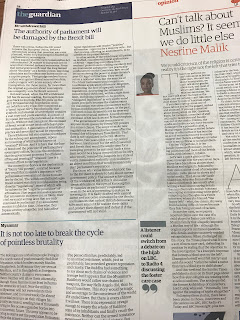Comparing Editorial Comment
 |
| The Guardian |
 |
| The Daily Mail |
In both the Guardian and Daily Mail there is a comment section situated around page 16-18. They both include a small masthead, column style, have an authoritative and persuasive tone, a subheading and multiple articles which are based on current affairs. Pictures are also sometimes included which can be images of the editor or writer of the article yet can be illustrations to emphasise the comments being written. This is not shown in the articles above but can been seen in other articles for example editor of the Daily Mail Sarah Vine often has her picture alongside her name at the top of the comment section. A by-line is also included in both newspapers.
Differences
The Guardian typically uses more formal and eloquent language in their comment section, for example 'burdensome bureaucracy' 'Eurosceptism' which conveys the higher class and educational audience of which the paper is aimed at. The comments as a whole are more objective compared to the Daily Mail yet bias compared to typical Guardian articles, due to the fact that it is a comment section so opinionated articles are expected. The Daily Mail is extremely bias with anti-Semitism and lexical field of extremism in the terrorism article shown above, "Attacks by 'lone wolves'" and "Jihadis returning from Syria still pose great danger".
In a political view the newspapers follow the ideologies of their paper as whole. The Guardian is more left-wing and the Daily Mail right wing. This is evident in some articles however it is not strongly shown in the articles above. The Daily Mail does show some of their political ideologies when they mention Brexit briefly in the terrorism article, 'We must seal our porous borders- something that will be considerably easier after Brexit" the use of the adjective 'porous' shows a pro-brexit opinion. The Daily Mail is more emotive compared to the Guardian which can be seen through the language used in the articles, for example 'bulling councils threaten us', this appeals to their target audience as they are typically lower or middle class and appeal to this emotive form of writing.
If we apply the uses and gratification theory to this we can see that people are attracted to these newspapers based on their identity, education, entertainment preferences and social interaction availability.
Frequent readers of the Daily mail may consume this type of newspaper as their viewpoints are similar to the newspapers ideology. Viewed politically the paper is more right wing so would be enjoyed and connected with through that, however if we view it on a wider scale many readers may enjoy the paper as it covers stories with the same viewpoint as the reader, therefore readers get a sense of pride when they appear to have a 'correct' viewpoint on a situation. The Daily mail lacks an educative side in the editorial comment as it focuses more on gossip, which the readers may enjoy and relate to as typically the readers are classified as groups C1, C2 and B and have a narrower education than Guardian readers who are typically classified as groups A and B on the ABC scale. This gossip element in the paper adds to the social interaction availability as conversation topics can occur consequently to this.
Readers of the Guardian consume this newspaper as they also connect with the content and viewpoint shared however obviously the issues covered are different. The Guardian covers a more educational side due to the ABC scale classification and has more of a political viewpoint that takes a left-wing side. Again this encourages frequent readership as the viewpoint is more or less matched between the commenter writing in the newspaper and the reader which leads to a sense of pride similar to the Daily Mail.
The Daily Mail satisfies the audience's need for entertainment more as the paper as a whole covers a more informal and celebrity based viewpoint which is emphasised in the editorial comment with the gossip based articles.
As previously stated the Guardian offers more of a educative side and lacks gossip, providing instead current affairs and culture.


A detailed response thanks to your focus on language register and tone to reveal bias. Next steps: How does the Uses and Gratifications model apply to this? What do audiences get from reading these products?
ReplyDelete